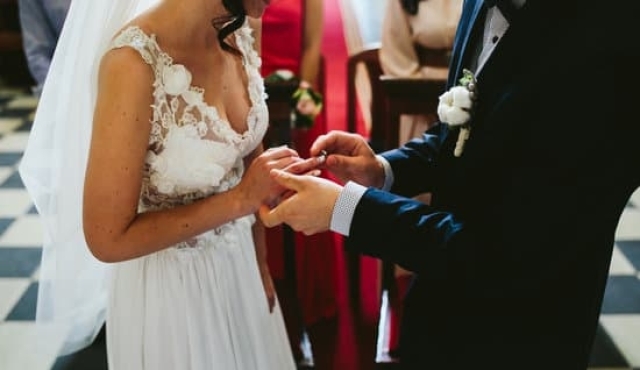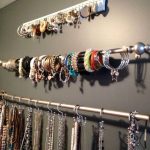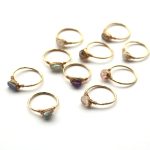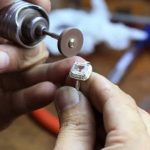This online course seeks to teach readers how to repair costume jewelry from a beginner level. Many people are interested in designing and repairing costumes as a hobby, but may not know where to start.
Costume jewelry is defined as items that are made out of imitation stones, such as rhinestones or plastic resins, and often have metals such as brass or steel. Because these materials are inexpensive, costume jewelry is highly affordable and can be used in many types of fashion statements.
Objectives: What You Will Learn
This online course focuses on teaching the basics of costume jewelry repair. Readers will learn how to identify different parts and pieces of costume jewelry and the various tools needed for repairs.
The course has several objectives including how to determine the value of costume jewelry, how to clean off tarnish and oxidation, how to remove broken pieces, how to make basic repairs like replacing lost or broken clamps and earring backs, how to repair chains and wires with new connectors, and much more.
Benefits Of Taking A How To Repair Costume Jewelry Online Course
Taking this course provides a number of benefits to readers who are interested in learning about costume jewelry repairs. It allows them to gain practical skills without having to attend a physical class or workshop. Additionally, readers can easily access information on their own schedule without worrying about any other commitments they may have during certain times.
Also, readers can potentially save money by understanding basic repairs that do not require professional assistance from a jeweler or other artisans – they only need some tools they can buy themselves at reasonable prices. Finally, since there is no limit to what you can learn through accessing an online resource-readers could potentially progress into higher levels of intermediate or expert craftsmanship over time if they so choose.
Overview of An Online Course
Today’s fashion-lovers know that costume jewelry can be a great way to add sparkle and panache to any outfit. Unfortunately, costume jewelry is often delicate, and sometimes needs repair in order to keep looking its best.
Learning the necessary repair techniques is an important skill for anyone who wants to keep their jewelry in top condition. While there are many physical courses available which teach these repair techniques, this online course offers a comprehensive overview of the skills needed to get your costume jewelry looking like new.
First, participants will learn how to identify different kinds of costume jewelry materials and components, as well as how they are connected. This knowledge is key to making successful repairs – without knowing what materials were used to construct the piece it becomes very difficult to replicate certain features as part of a repair job.
The course then covers practical information on required tools, tips for working on specific types of materials such as plastic or semi-precious stones, techniques for putting back missing components such as beads or enamel pieces, and advice on gluing different pieces together with adhesives suitable for the material in question.
This provides the foundation for more advanced concepts, such as distinguishing between quality solid gold pins and cheaper simulated gold ones, or alteration procedures from restyling existing pieces into something completely new. In addition, students will also get insight on setting up a professional jewelry repair business if they are so inclined – perfect for entrepreneurs who want use their newfound skills as a source of income.
At the end of this course productively you will be equipped with enough confidence and knowledge to professionally repair any kind of costume jewelry without breaks or damages occurring afterwards during function or wear. You will be able to make professional judgments based off sound conclusions you have drawn from your investigative work when dealing with repair work given by customers needing your help repairing their beloved jewellery items.
Not only this but also be familiar with standard practices often employed during jewellery repairs when dealing with clients who expect nothing but guaranteed satisfaction concerning their jewellery fixings or simple customisation requests they may need avaliable services fulfilled through your expert workmanship you’ve obtained while completing this comprehensive online course.
Identifying and Being Prepared for Common Damage to the Jewelry
As a jewelry lover, you most likely own pieces of costume jewelry that you treasure and would love to be able to repair. Even the most beautiful pieces of costume jewelry can incur wear and tear, chipping or discoloration over the years. It is important to recognize when damage to your jewelry has occurred and be prepared to repair it.
The first step in identifying and being prepared for any damage to costume jewelry is taking a watchful eye as you take on wearing it. Knowing how your jewelry should look while being worn will help you notice any changes or signs of potential damage instantaneously so that you can move swiftly if repairs are needed.
Pay attention not only to chips or discolorations but also loose settings or stone attachments on the piece. Keep an eye out for clasps that no longer hold well when closed or signs of rust on metal parts.
Aside from inspecting your costume jewelry while wearing it, there are a few extra steps one can take to stay ahead of potential damages and ensure their collection stays healthy over time. First, create an airtight environment for storing all jewelry pieces away from sunlight and humidity which are two elements that can encourage tarnishing and fading of certain materials used in making these precious items.
Additionally, use a soft cloth to store the pieces against each other as this is less abrasive than other cloths that might scratch the surfaces of more delicate materials such as crystal beads found in necklaces or earrings. Finally, regular treatments of dainty boxes with wood preservatives like beeswax can keep elements from seeping through the sides resulting in scratched cubes or tarnished metals inside your cases.
An online course such as “How To Repair Costume Jewelry” can provide valuable information between maintaining and repairing your favorite pieces of Costume Jewelry If taken properly, this course could react quickly in repairing small damages to even handling worn-out surfaces completely by providing essential resources necessary towards fixing up those special items of yours once again.
With topics ranging from simple techniques such as cleaning methods, mending broken links with pliers all the way through relaying concepts such as learning proper gluing techniques with professional grade solutions – ultimately these efforts will maximize those chances at restoring back its natural beauty one day.
Researching and Gaining Access to Proper Supplies
Before beginning the process of learning how to repair costume jewelry, it’s essential for a person to do their research in terms of finding materials and supplies necessary for proper repairs. This may include various types of craft tools, including adhesive epoxy glue, wire cutters, and magnifying glasses.
It’s important to make sure all the necessary items are obtained prior to fixing any broken jewelry. As there are numerous suppliers out there who can provide suitable items at an affordable price, you need to evaluate options such as product quality and shipping costs so that you have access to reliable products.
Using Professional-Grade Glue
When it comes time to actually begin repairing the costume jewelry, professional-grade glue is often the most preferred way for making repairs on jewelry pieces that don’t require many small parts or intricate designs. Another advantage of using this type of adhesive is that it usually dries fairly quickly once applied.
Other glues such as superglue or Krazy Glues may not always stick as well as some professional grade adhesives which makes it important to have access to quality glues when attempting a repair.
Proper Maintenance of Jewelry Tools
Finally, when engaging in the task of repairing costume jewelry, it’s important to ensure proper maintenance of the tools used in your work area. This includes keeping them clean at all times by wiping them down with a damp cloth before and after each use and regularly applying lubricant if they’re made up with metal components so they continue running smoothly.
Additionally, you also should store your tools in designated spaces such as toolboxes so that they remain secure when not in use. Taking care of craft supplies ensures longer lifespans and allows them to maintain their effectiveness over time which saves both time and money.
Assessing the Condition of the Jewelry
Once you have the jewelry in hand, the first step of repair is assessing its condition. Inspecting the piece with a magnifying loop should be your go-to action and your first estimate as to what material it has been made from. It is important to understand that different materials may require different tools and techniques for effective repairs.
Once you identify what type of material you are working with, look closer for details such as chips or cracks in the surface of beads orfasteners that may need secure replacements. Reviewing the condition of all details on a piece can provide an estimation of cost, time and effort needed to complete a repair job.
Selecting the Appropriate Tools
The next step is choosing the right sort of tools that are required for the jewelry repairs. Before beginning actual job repairs, assemble pliers, metal files and other assorted tools according to what type of metal or stone material you will be dealing with.
As costume jewelry typically has dozens of tiny components, owning dedicated miniatures and toolsets that can be accessorized is especially important when it comes to repairing intricate works. An array of bead accessories including tweezers and wire clippers will also come in handy during drilling and setting sequins into place
Making Repairs
Think through a repair process before actively beginning it – this helps keep an even flow when working on such intricate pieces and eliminates any mistakes created by overworking an area because of wrong placement or taking out unnecessary parts due to misunderstandings while removing them. After completing a task check thoroughly through each component again before moving onto the next one – this allows spottingissues that weren’t visible or considered beforehand.
With patience and attention to detail, even complex repairs can be done quite affordably keeping in mind professional quality requirements simultaneously.
Tips and Tricks for Making Repairs
An online course on how to repair costume jewelry can open up an array of possibilities, as well as enable individuals to become experts in the process. By taking this type of course, people not only gain knowledge and skillful expertise but also an understanding of necessary tools, materials, and practices that are used when attempting these types of repairs.
To start off the course, learners should become familiar with the different types of costume jewelry they will be working with. This includes learning how to identify the various components of such items such as beads, stones, findings, plating finishes and metals used in the making. Once this knowledge is thoroughly understood, people will be able to repair costume jewelry correctly and make sure that any work that has been done would last for years to come.
The next step is to learn about the types of materials that are available for use when conducting repairs on costume jewelry. Depending on what type of item needs repaired (i.e., a necklace or a bracelet), different materials may need to be sourced in order to successfully complete the task at hand. It is important for learners to understand these details so they can determine which material might be most suitable for any given project.
Learners should also pay close attention to surface treatments for various pieces since this could affect how easy certain maintenance tasks are accomplished (polishing or cleaning). Also covered in this online course would be techniques such as soldering and filing used when properly repairing costume jewelry items.
By investing effort into learning how to repair costume jewelry through an online course like this one, users can gain valuable skills and knowledge plus a deeper appreciation for all things related to fashion restoration activities that can open up more career opportunities down the line or even just provide entertainment during free time activities.
Carefully Polish and Shine the Jewelry
Learning how to repair costume jewelry can be a valuable asset. Not only can you save money on buying new pieces as you know how to fix that special piece of jewelry, but also it can help you earn money as a side hustle by being able to repair for other people and reselling the repairs. Here is an easy guide on how to repair costume jewelry, starting with polishing and shining the piece.
To begin you will need some quality polishing cloths or armor-all wipes, so the first step is to make sure that you have all the supplies that you need. Many people get these items from local retailers or online stores.
Once your materials are collected, start by removing dirt off of the jewelry if needed. You may use a toothbrush and warm water along with some dish soap, rubbing gently until most of the dirt is removed then rinsing it off with warm water, followed by letting it air dry.
Now it’s time to start polishing your costume jewelry. If it is made of plastic or rubber, usually a mild abrasive polish will work fine and leave the material in great condition and spotless. After any loose particles have been removed just like dirt, begin buffing away at the material with a buffing wheel.
Be sure not to over press while buffing because this might cause damage to parts of jewelry it shouldn’t touch such as stones diamonds etc. Buff out every crevice on both sides activating all surfaces evenly in circular motions until finished then following up by cleaning with Armor-all type wipe for best results.
Properly Storing and Preserving the Jewelry
Storing costume jewelry is essential in maintaining its beauty and value. Although lightweight, costume jewelry can be delicate due to the soft metals and glass used to produce it. While many pieces are aged to give them an antique look, they can still be damaged if not stored and handled correctly. The following tips will help you store and preserve your costume jewelry collection.
The first thing you should do is keep costume jewelry out of direct sunlight. Sun rays cause metal to tarnish much faster, so be sure to avoid prolonged exposure to the sun’s UV rays.
Keep your jewelry away from heat sources such as radiators or electric blankets, as extreme heat can cause metal pieces to bend out of shape over time. Placing a piece of acid-free cloth paper or felt between each piece will not only protect them from scratches but also act as a barrier against sweat or moisture that accumulates when stored for long periods of time.
If you plan on wearing your costume jewelry often, consider storing it in a special pouch lined with cotton or velvet that prevents any sudden movement and shocks which can easily damage the smaller components like beads and stones. You may also want to organize your collection based on the type of metal they are composed of; gold pieces should be separated from silver ones as the two tend to react differently when exposed to humidity in the air.
This will allow you to spot potential problems more easily while cleaning and restoring each piece of Jewelry.
Last but not least is proper cleaning; check for wear or signs of oxidation before wiping it carefully with a lint-free cloth moistened with warm water mixed with a mild non-ionic detergent that does not react chemically when in contact with metals or stones (check for instructions on product label).
Never use tissue or paper towels – these are too coarse for jewelry – instead opt for cotton swabs, toothpicks, tweezers and other studio tools used specifically for cleaning small objects like earrings, pendants, beads or necklaces; drying each item before putting away into its respective compartment is essential in preventing rusting over time.
Summary
The art of jewelry making is a profession that has been around for centuries, and costume jewelry has been popular since the 1950s. Learning how to repair costume jewelry is an invaluable skill and can be done in the comfort of your own home without any prior experience.
By taking an online course to repair costume jewelry, you will gain access to valuable resources like online instruction videos, tutorials, and workshops. This means you can learn at your own pace and become knowledgeable about repairs quickly.
By doing all the hard work online, you eliminate the need to attend paid seminars or classes outside of your home. By taking an online course, you save time as well as money since these classes often include helpful discounts on materials, tools, and supplies needed for successful repair projects.
The courses also come with detailed instructions that are easy to understand if you have never worked with jewelry before. This helps beginners get the most out of their investment in this learning endeavor.
Additionally, many of these courses teach students simple tricks for fixing holes or scratches in precious metals so that they look like new again. With options like metal plating and polishing available through some online courses, it may be possible to restore some treasured pieces back to their original beauty without breaking the bank. These old pieces can be seen in another light after getting a makeover from a professional-level education offered through an online course.
Another great benefit from most of these courses is the inclusion of finishing touches like antique patterns and unique designs which add character and charm to each piece. By learning all aspects of costume jewelry repairs through an online course makes it easier for students to feel more confident about tackling difficult projects on their own instead of having them repaired by a store professional or jeweler.

Welcome to my jewelry blog! My name is Sarah and I am the owner of this blog.
I love making jewelry and sharing my creations with others.
So whether you’re someone who loves wearing jewelry yourself or simply enjoys learning about it, be sure to check out my blog for insightful posts on everything related to this exciting topic!





